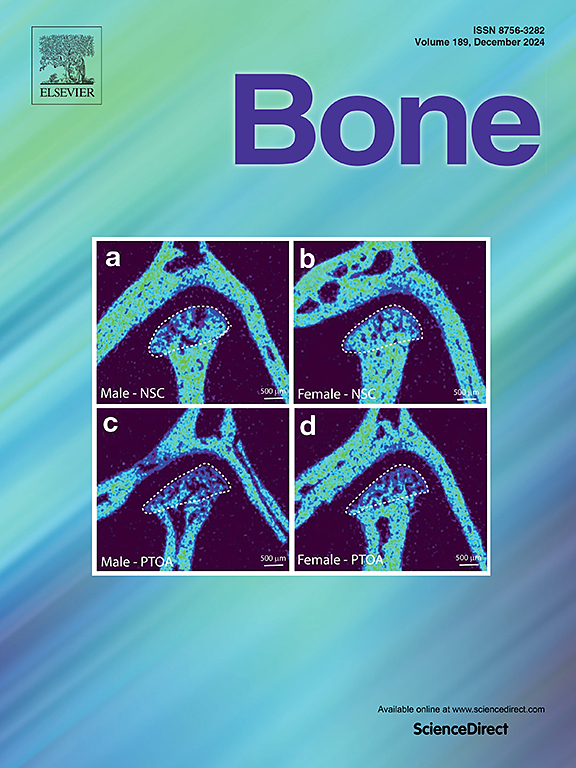全反式维甲酸对泼尼松龙诱导的斑马鱼幼体骨质疏松症的影响
IF 3.5
2区 医学
Q2 ENDOCRINOLOGY & METABOLISM
引用次数: 0
摘要
糖皮质激素(GCs)被广泛用作抗炎和免疫抑制剂,长期用于治疗风湿性疾病、呼吸系统疾病、肾脏疾病和器官移植。长期使用糖皮质激素会降低骨质密度,导致骨质疏松症(糖皮质激素诱发骨质疏松症,GIOP)和骨折。全反式维甲酸(ATRA)是一种活性维生素 A 代谢物,可调节胚胎发育和成人器官功能。研究发现,ATRA 可促进骨生成。为了研究 ATRA 对 GIOP 的干预作用以及 ATRA 的活动机制,我们首先进行了生物信息学分析,以确定 ATRA 的潜在基因靶标。我们将斑马鱼幼体作为实验动物,并给幼体注射常用的GC--泼尼松龙来构建GIOP模型。我们评估了外源性 ATRA 对 GIOP 斑马鱼幼体骨代谢酶活性、成骨细胞和破骨细胞相关基因表达以及骨矿密度和骨量恢复的影响。此外,我们还利用吗啡基诺敲除法研究了 ATRA 在抗 GIOP 过程中转录辅激活剂和负互作因子 RBM14 对成骨细胞基因表达调控的影响。骨代谢酶活性(碱性磷酸酶(ALP)和耐酒石酸磷酸酶(TRAP))和成骨细胞标记基因(Runx2a、Runx2b、SP7、Csf1a、RANKL和CTSK)的表达检测结果表明,ATRA对成骨具有双向作用。然而,在 GIOP 模型中,ATRA 通过抑制 GIOP 诱导的成骨代谢酶(ALP)活性和成骨标志基因(Runx2a、Runx2b 和 SP7)表达,逆转了 GIOP 诱导的骨质疏松症表型,而且这种拮抗作用是浓度依赖性的。我们还观察到,ATRA 可抑制 RBM14 在斑马鱼幼体中的表达,而单独使用 ATRA 和 RBM14 基因敲除均可诱导成骨细胞标记基因的表达,这意味着 ATRA 对 RBM14 表达的抑制作用可能是 ATRA 成骨作用的基础。基于这些数据,我们推测 ATRA 可能通过降低 RBM14 的表达来改善 GIOP,从而增强成骨细胞标记基因的表达。本文章由计算机程序翻译,如有差异,请以英文原文为准。
The effects of all-trans retinoic acid on prednisolone-induced osteoporosis in zebrafish larvae
Glucocorticoids (GCs) are extensively used as anti-inflammatory and immunosuppressive medications in the long-term treatment of rheumatic disorders, respiratory diseases, renal diseases, and organ transplantation. Prolonged use of GCs can reduce bone mineral density, leading to osteoporosis (Glucocorticoid Induced Osteoporosis, GIOP) and fracture. All-trans retinoic acid (ATRA) is an active vitamin A metabolite that regulates embryonic development and adult organ function. ATRA has been found in studies to enhance osteogenesis. To examine the interventional effects of ATRA on GIOP and the mechanisms of ATRA activities, we first performed bioinformatic analysis to identify potential gene targets of ATRA. Zebrafish larvae were recruited as experimental animals, and the frequently used GC, prednisolone, was administered to larvae to construct a GIOP model. We evaluated the influence of exogenous ATRA on the activities of bone metabolic enzymes, the expression of genes linked to osteoblasts and osteoclasts, and the restoration of bone mineral density and bone mass in GIOP zebrafish larvae. Furthermore, we studied the influence of RBM14, a transcriptional coactivator and negative reciprocal factor of ATRA, on the regulation of osteoblastic gene expression during the anti-GIOP process of ATRA using the morpholino knockdown approach. The findings of bone metabolic enzyme activity (alkaline phosphatase, ALP and tartrate-resistant acid phosphatase, TRAP) and expression assays of osteoblastic marker genes (Runx2a, Runx2b, SP7, Csf1a, RANKL, and CTSK) indicated that ATRA had bidirectional effects on osteogenesis. However, in the GIOP model, ATRA reversed the GIOP-induced osteoporosis phenotype by inhibiting the GIOP-induced suppression of osteoblastic metabolic enzyme (ALP) activities and osteoblastic marker gene expression (Runx2a, Runx2b, and SP7), and this antagonism was concentration-dependent. We also observed that ATRA inhibited RBM14 expression in zebrafish larvae, while ATRA alone and RBM14 knockdown showed a consistent induction of osteoblast marker gene expression, implying that ATRA's inhibitory effect on RBM14 expression may underlie ATRA's osteogenic effects. Based on these data, we postulated that ATRA may ameliorate GIOP by decreasing RBM14 expression, thereby enhancing osteoblastic marker gene expression.
求助全文
通过发布文献求助,成功后即可免费获取论文全文。
去求助
来源期刊

Bone
医学-内分泌学与代谢
CiteScore
8.90
自引率
4.90%
发文量
264
审稿时长
30 days
期刊介绍:
BONE is an interdisciplinary forum for the rapid publication of original articles and reviews on basic, translational, and clinical aspects of bone and mineral metabolism. The Journal also encourages submissions related to interactions of bone with other organ systems, including cartilage, endocrine, muscle, fat, neural, vascular, gastrointestinal, hematopoietic, and immune systems. Particular attention is placed on the application of experimental studies to clinical practice.
 求助内容:
求助内容: 应助结果提醒方式:
应助结果提醒方式:


